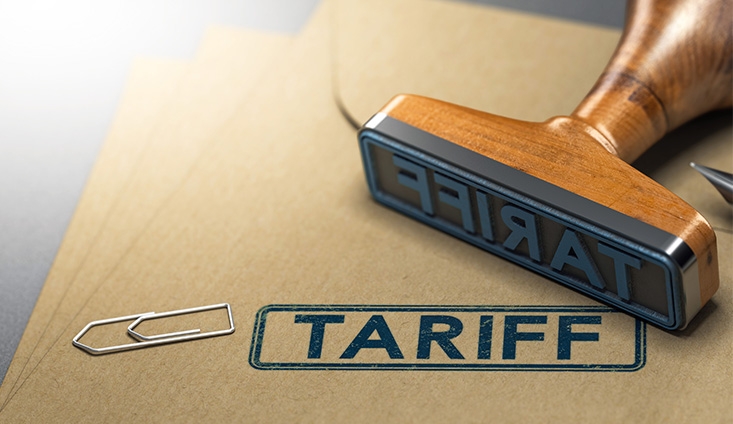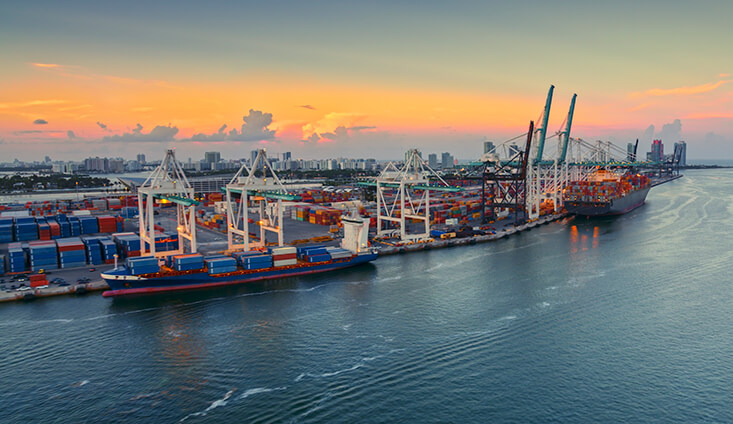Shipper | Market updates 4 min. read
Navigating disruption: How to prepare for tariffs

In the face of recently announced tariffs, companies across North America are adopting various strategies to safeguard their supply chains.
Each shipper's approach to sourcing, warehousing, importing, exporting, and distribution is unique, reflecting the diverse nature of their operations.
This article explores how to prepare for tariffs, highlighting how companies are implementing a variety of strategies as well as steps you can take to help increase your network’s resiliency and adaptability within the rapidly changing trade environment.
What are tariffs, and how do they work?
A tariff is a tax implemented by the government on goods or services imported from other countries.
These taxes can be issued for a variety of reasons, including:
Raising revenue for the government.
Encouraging or protecting domestic industries and manufacturing.
Exerting political leverage.
When goods enter the country, the importing companies pay a tax, which can apply to anything from raw supplies and manufacturing parts to finished products. Tariffs often cause an increase in prices for consumers and businesses and can even compound if manufactured goods and their parts cross the border multiple times.

How are companies preparing for tariffs?
As a carrier with one of the broadest portfolios of services in the industry, we at Schneider have had the unique opportunity to support, provide solutions for, and share our expertise with shippers across North America as they prepare for tariffs to take effect.
Companies preparing for tariffs commonly utilize these strategies to lessen the impact tariffs may have on their business:
Evaluating international and domestic supply chains
With current tariffs heavily targeting some of the United States' top trade partners, some shippers are considering moving their production to the United States or other countries that are less directly impacted by tariffs and offer comparable production and labor costs. Meanwhile, shippers who want to minimize imports as a whole are looking into expanding their domestic production footprint.
Pull forward inventory
Many companies that rely heavily on supplies or products manufactured in other countries have been trying to reduce disruptions by pulling forward inventory and ordering parts in advance to shorten lead times in volatile categories. This has increased the need for additional warehouse space and cross-border capacity among these shippers.
Waiting and monitoring the situation
Due to the uncertainty around the proposed tariffs, some shippers have decided not to act until they know exactly what tariffs will take effect, how long they will remain in place, or if they will be subject to re-negotiation. These shippers are watching the situation closely to determine potential impacts and costs to their business before solidifying their plans and acting in real time.
Carrying on business as usual
Many smaller or primarily domestic companies do not rely heavily on imports to conduct business, making the overall impact on their business minimal, so they will continue operating without much change. Others will do the same, but they may need to make pricing adjustments within their supply chain to offset the tariffs.

Navigating tariffs with 3 smart shippings strategies
As noted, there isn’t a one size fits all solution when it comes to preparing for tariffs. However, there are a few steps strategic shippers can take to ensure they are better positioned to navigate tariffs within their supply chain.
Utilize multiple transportation modes
Diversifying the mode mix within your supply chain can enhance the reliability and flexibility of capacity in a number of ways. First, using a mix of transportation modes allows shippers to mitigate capacity constraints that may result from tariff-induced shifts in trade volumes, as solutions like intermodal are able to move significantly more cargo via train vs. standard over-the-road shipping.
Additionally, using a diverse mode mix allows shippers to switch to alternative routing or modes when disruptions like slowdowns at the border occur.
Select carriers that offer a wide range of services
Things can change at a moment’s notice, but working with a carrier that has a broad portfolio of services can make it easier to flexibly adapt to disruptions, such as needing warehousing space for extra inventory, port dray services for import and export support, cross-border expertise, brokerage for timely capacity or multimodal options.
This flexibility ensures quicker and easier adjustments, maintaining efficiency and minimizing the impact of unexpected changes.
Analyze your logistics network
When preparing for tariffs, it’s important to analyze the flow of your domestic and international logistics networks to identify inefficiencies, bottlenecks and vulnerabilities. Having a strong understanding of your supply chain allows you to develop more strategic and flexible contingency plans to minimize disruption.
Conducting a supply chain assessment with a strategic carrier is an effective way to gain these insights and ensure the network is optimized for tariff impacts.
Schneider can help.
We understand this is an evolving situation, and your strategy may change day to day, but no matter what approach you're taking to navigate the ongoing geopolitical environment, Schneider can help you develop and execute your plans.
With 90 years of transportation experience under our belts, Schneider’s team of logistics experts are available to help you find the right solutions for your business.
Related resources
Drive your business forward
Sign up to receive our industry leading newsletter with case studies and insights you can put to use for your business.












